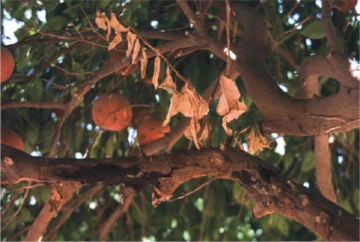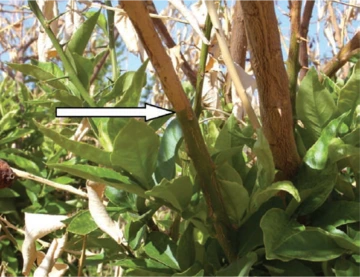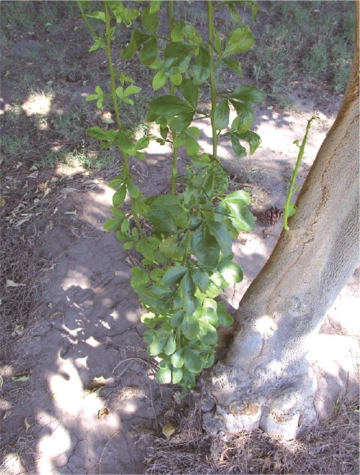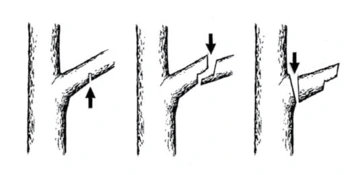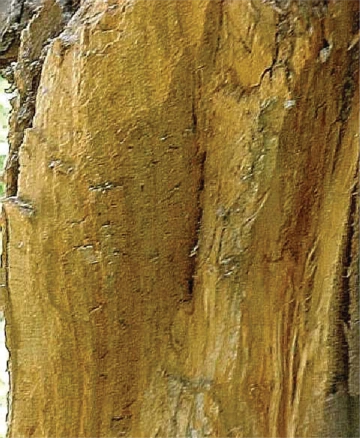Pruning is a common task necessary for best production of many common fruit trees. Most types of deciduous trees are pruned to invigorate the tree, to improve branch configuration, and thus make branches less likely to split under a heavy crop, to improve fruit quality, and/or to reduce the crop load which will improve the potential size of individual fruits.
- Prune citrus to eliminate sprouts, remove weak, crossing or dead branches, or to allow more light in the canopy.
- February through April are the best months to prune.
- Remove all sprouts originating from the trunk. Most sprouts are best removed by hand when they are small.
- Remove branches at the collar using a three-part cut.
- Citrus trees need not be skirted except for aesthetical reasons.
- Citrus trees may be easily hedged.
- Protect exposed wood from the sun using latex paint or whitewash.
Homeowners with previous experience pruning deciduous trees often assume that citrus trees should be pruned similarly. However citrus wood is naturally strong and is not as likely to break under the stress of a large fruit load. Furthermore, citrus trees can produce fruit in all but the most shaded part of the tree, and need not be regularly pruned to allow more light into the interior of the canopy. Even when the crop load is heavy, individual fruit size is large, so pruning to reduce the crop load and improve fruit size is not necessary except occasionally with tangerines. Finally, citrus fruit quality is typically just as good or better from a minimally pruned tree as compared with one that is heavily pruned.
Nevertheless, citrus trees should not be left completely unpruned. Proper citrus care for the young tree should include sprout removal, and cautious elimination of weak limbs within the tree canopy. For mature trees, sprouts should be removed regularly, deadwood should be pruned out, and diseased or crisscrossing limbs should be removed. If there is no interior fruit, the center of the canopy may need to be opened up to improve light penetration. Also, the bottom of the canopy may need to be removed (“skirting”).
When to prune
Regular pruning for desert-grown citrus trees should take place in the spring, between February and April. Citrus-growing areas of the state which are cooler should delay the beginning of pruning until late-February or March. Most pruning that requires tools should occur at this time. Pruning may be done prior to bloom, and it is important to note that although flowers may not be seen, they exist in a microscopic stage and will be lost due to pruning. However, unless pruning is drastic, yield loss will be minimal.
If pruning exposes large limbs or the trunk to the sunlight, completing the job in the late winter and spring allows the tree sufficient time to grow new foliage that will shade the newly-exposed wood within the canopy before it is subject to the harsh summer sun. It is not generally recommend to prune citrus from May through the middle of October since exposed limbs and trunks can be damaged by intense sunlight, possibly leading to sunscald or an infestation of Hendersonula bark rot (sooty mold); a disease for which there is no cure other than limb removal (Figure 1). We recommend summer removal of large limbs and large sprouts only in cases where damage is present, and where further delay would lead to additional injury. Whenever and wherever trunk or limbs are exposed to the sun, they should be protected with white paint.
Sprouts and small branches, removed by hand or with hand pruners, may be taken off at any time. We do not recommend extensive pruning from November though January, since pruning often stimulates tender re-growth which is susceptible to freeze damage.
If trees have been damaged by a freeze, it is best not to prune them immediately. Loose, split bark and oozing are immediate signs of injury, but damage may be more extensive. Freeze-damaged trees will sometimes put out a growth flush which will die off in the late spring. New growth (or the lack of such growth) will show the damage after several months. Once any damage is evident, typically by early summer (Figure 2), it is time to remove dead branches by cutting back several inches into healthy, green wood, then protecting the large limbs that are cut with diluted latex paint.
What to prune
Sprouts
Branches
Hedging
Citrus trees can be hedged if necessary. Citrus trees may be planted close together, and will form an impenetrable hedge if allowed to do so. In time, fruit production will decrease in the interior of the trees because of excessive shading. Manual or electric hedgers may be used, and the blade should always be sharp.
How to prune
Sprouts
Sprouts are best removed by hand when they are small. They will break off easily and removal will not damage the tree. When they are larger, hand pruners should be used to make a smooth cut and avoid damaging the tree. Sprouts should never be allowed to get so large so that a lopper or saw is necessary. For small trees, sprouts will grow from the trunk and should be removed regularly, perhaps as often as once a month. A good “rule of thumb” is to keep the lower 10 to 12 inches of trunk free of sprouts. White cardboard can also be wrapped around the trunk to inhibit sprouting. As trees get larger, sprout production will decrease, and removal need not occur as often. If a hand pruner must be used, remove the sprout at its base, leaving no stub, but retaining the branch collar. The collar is the swollen area of trunk tissue that forms around the base of a branch and that will protect the tree from decay. The tree will heal the wound beginning with tissue that grows from the collar. Do not leave a jagged cut, and be sure the tool is sharp. There is no need to use pruning paint or other compounds to cover the wound, the tree will heal naturally.
Branches
Branches cannot be removed with the fingers, but must be removed with a tool. For smaller branches, hand pruners or loppers can be used. For larger branches, a curved tree saw with a sharp blade is the best tool.
Regardless of branch size, if no re-growth is wanted, prune the branch flush with the collar, not flush with the trunk. Pruning flush with the collar will give the tree the best chance to heal, and will minimize sprout re-growth at the point of the cut.
When cutting branches over 1½ inch in diameter, use a 3-part cut. (Figure 5) For the first cut, choose a location 6 to 12 inches out from the collar. Saw through about 1/3 of the branch starting from the underside. This is called the undercut, and will keep the bark from tearing. Then, remove the weight of the branch by making a second cut about 3 inches further out from the undercut, cutting completely through the branch, from top to bottom, until the branch falls away. Finally, cut the resulting stub back to the branch collar. Make sure the cut is smooth. The tree will heal the wound itself, beginning with tissue that develops from the collar. No pruning paint or sealant is necessary.
Diseased branches should be cut back or removed completely. If the affected branch is to be cut back, be sure that the cut is made into healthy wood. Healthy wood is whitish-yellow, the color of a manila folder. Any darker wood visible at the cut is an indication that disease still exists (Figure 6).
Hedging
Hedging is best done with a mechanical or power hedging tool. Be sure the tool is sharp. Branches with more than ½ inch diameter should be cut with a pruning saw or lopper.
Protecting the tree
If the trunk or branches are newly exposed to the sun as a result of pruning, they should be protected. Likewise, if the trunk of a tree is not shaded by the canopy, protective measures should be taken. Liberally paint the exposed wood with white latex or other standard tree paint. Latex paint can be diluted by 50% with water, or one can use whitewash. Do not use an oil-based paint.


